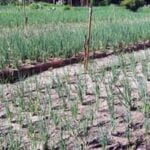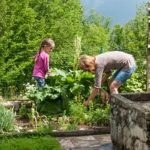Are you interested in growing your own vegetables but don’t have a traditional garden space? Container gardening could be the perfect solution, especially in the fall. In this article, we will explore the best fall vegetables for container gardening and provide tips for a successful harvest.
Container gardening offers a convenient and space-efficient way to grow your favorite vegetables, and it’s particularly well-suited for the fall season. Whether you’re limited on outdoor space or simply want to extend your gardening season, growing fall vegetables in containers can be a rewarding experience. From crisp lettuce to colorful carrots, there are plenty of options to choose from when it comes to fall container gardening.
In the following sections, we’ll discuss the benefits of container gardening in the fall, offer tips for selecting the best containers, and provide a comprehensive list of the top vegetables that thrive in containers during the autumn season. Whether you’re a beginner or experienced gardener, this guide will help you make the most of your fall container garden. So grab your pots and soil – it’s time to get planting.
Benefits of Container Gardening in the Fall
Fall is a great time to explore the possibilities of container gardening, especially when it comes to growing vegetables. There are numerous benefits to engaging in this activity during the autumn season, from the convenience of having fresh produce right at your fingertips to the ability to extend the growing season. Let’s take a closer look at why container gardening in the fall can be such a rewarding endeavor.
Extended Growing Season
One of the main advantages of fall container gardening is the ability to extend the growing season. By planting vegetables in containers, you can easily move them indoors or into a greenhouse as temperatures drop, allowing you to continue harvesting fresh produce well into the fall and even early winter months.
Space Flexibility
Container gardening also offers great flexibility when it comes to space. Whether you have limited outdoor space or simply want to bring some greenery onto your patio or balcony, growing fall vegetables in containers allows you to make use of any available area. Additionally, containers can be moved around as needed to optimize sunlight exposure for your plants.
Protection From Pests and Diseases
Another benefit of fall container gardening is that it provides an added layer of protection against pests and diseases. By keeping your vegetables in containers, you can better control their environment and reduce the risk of infestations or infections that may occur in traditional garden beds. This can result in healthier plants and higher yields of delicious fall vegetables.
Overall, container gardening during the fall offers numerous advantages that make it an attractive option for those looking to grow their own fresh produce. With proper care and attention, you can enjoy a bountiful harvest of some of the best fall vegetables for container gardening.
Choosing the Right Containers
When it comes to container gardening, choosing the right containers is crucial for the success of your fall vegetable garden. The type and size of the containers you select can greatly impact the growth and health of your plants. Here are some tips for selecting the best containers for fall vegetable gardening:
Material
When choosing containers for fall vegetable gardening, consider the material of the pots. Plastic, ceramic, wood, and even fabric pots are all viable options. Each material has its own set of advantages and disadvantages. For example, plastic pots are lightweight and retain moisture well, while ceramic pots are durable but heavy. Consider the specific needs of the vegetables you plan to grow in order to select the most suitable material for your containers.
Size
The size of your containers is also an important factor to consider. Different vegetables have different root systems and space requirements. For example, larger vegetables such as tomatoes and peppers will need bigger containers to accommodate their roots, while smaller greens like lettuce or spinach can thrive in smaller pots. Be sure to research the specific spacing needs of each vegetable you plan to grow and choose containers accordingly.
Drainage
Proper drainage is essential for container gardening in general, but particularly important when growing fall vegetables. Ensure that your chosen containers have adequate drainage holes to prevent waterlogged soil, which can lead to root rot and other issues. Additionally, consider elevating your containers on pot feet or placing them on a slatted surface to improve airflow and drainage.
By carefully considering the material, size, and drainage capabilities of your containers, you can set yourself up for success when it comes to fall vegetable gardening in containers. Taking these factors into account will help create an optimal growing environment for your plants and ultimately lead to a bountiful harvest of delicious fall produce.
Best Fall Vegetables for Container Gardening
When it comes to container gardening in the fall, there are a variety of vegetables that are well-suited for this season. From hearty greens to flavorful root vegetables, growing fall vegetables in containers can be a rewarding experience. Whether you have limited outdoor space or simply prefer the convenience of container gardening, there are plenty of options to choose from. Below is a comprehensive list of the best fall vegetables for container gardening.
One of the top choices for fall container gardening is kale. This leafy green vegetable thrives in cooler temperatures and can be grown successfully in containers. Additionally, carrots are an excellent option for fall container gardening, as they can tolerate chilly weather and their slender roots make them well-suited for growing in pots.
Another great option for growing in containers during the fall season is beets. These vibrant and nutritious root vegetables can be grown in compact spaces and add a pop of color to your garden. Additionally, radishes are quick-growing and perfect for container gardening, making them an ideal choice for fall.
| Vegetable | Growing Conditions |
|---|---|
| Kale | Cooler temperatures, well-draining soil |
| Carrots | Tolerant of chilly weather, slender roots suitable for pots |
| Beets | Compact growth, vibrant colors, easy to grow in containers |
| Radishes | Quick-growing, perfect for container gardening |
These are just a few examples of the best fall vegetables for container gardening. By choosing the right varieties and providing proper care, you can enjoy a bountiful harvest of fresh and delicious produce throughout the autumn season. With some planning and attention to detail, your fall container garden can thrive with an abundance of nutrient-rich vegetables that can be enjoyed throughout the season.
Tips for Successful Fall Container Gardening
Fall container gardening can be a rewarding and fruitful endeavor, especially when done right. To ensure a bountiful harvest of the best fall vegetables for container gardening, there are several expert tips to keep in mind.
First and foremost, it’s essential to choose the right location for your container garden. Most fall vegetables require full sun, so be sure to place your containers in an area that receives at least 6-8 hours of direct sunlight each day. Additionally, consider the temperature fluctuations in the fall season and be mindful of any potential frost. You may need to move your containers indoors or cover them with a protective cloth during cooler nights.
Another important tip is to select the appropriate containers for your fall vegetable garden. Choose pots or containers that are large enough to accommodate the root systems of the vegetables you plan to grow. Good drainage is also crucial, as excess water can lead to root rot and other issues. Consider using containers with drainage holes or adding a layer of gravel at the bottom to prevent waterlogging.
In addition, proper watering and fertilizing are vital for successful fall container gardening. Be attentive to the moisture levels in your containers, as autumn weather can be unpredictable. Water your vegetables regularly, but be cautious not to overwater them. Additionally, consider feeding your plants with a balanced fertilizer every few weeks to support healthy growth and abundant yields.
| Expert Tip | Description |
|---|---|
| Choose the right location | Ensure containers receive 6-8 hours of sunlight each day and protect them from temperature fluctuations. |
| Select appropriate containers | Choose pots with good drainage and ample space for vegetable root systems. |
| Proper watering and fertilizing | Water regularly without overdoing it and use balanced fertilizer every few weeks. |
Maintenance and Care
Maintaining and caring for fall vegetables in containers is crucial to ensure a bountiful harvest. Here are some essential tips for keeping your fall container garden healthy and thriving:
- Watering: During the fall season, it’s important to monitor the moisture levels of your container garden. While the cooler temperatures may result in less evaporation, plants still need adequate water to thrive. Be sure to water your vegetables regularly, checking the soil moisture with your finger to determine when it’s time for watering. Consider using a watering can with a narrow spout to deliver water directly to the base of the plants.
- Fertilizing: As your fall vegetables grow and develop, they will benefit from regular fertilization. Choose a balanced, slow-release fertilizer specifically designed for vegetables and follow the application instructions on the packaging. Applying fertilizer every few weeks can help promote healthy growth and abundant yields.
- Pruning and Pest Control: Keep an eye on your container garden for any signs of pests or diseases that may threaten your fall vegetables. Regularly inspect the leaves and stems for any abnormalities, and promptly address any issues that arise. Additionally, pruning can help improve air circulation and keep plants healthy.
In addition to these general maintenance tasks, it’s important to pay attention to the specific needs of each type of vegetable you’re growing in containers. Some plants may require additional care or specific growing conditions, so be sure to conduct research on the best practices for each variety.
By providing proper maintenance and care for your fall vegetables in containers, you can ensure a successful harvest of fresh, delicious produce right at home.
Overcoming Common Challenges
When it comes to fall container gardening, there are certain challenges that gardeners may face. However, with the right knowledge and techniques, these obstacles can be overcome to ensure a successful harvest of fall vegetables. Here are some common challenges and how to address them:
1. Limited sunlight: During the fall season, the amount of sunlight available for growing vegetables may decrease. To overcome this challenge, it is important to place your containers in areas that receive the most sunlight possible. Additionally, consider using reflective materials or placing mirrors strategically to bounce light back onto your vegetable plants.
2. Cold temperatures: As the weather gets colder in the fall, it can pose a threat to the growth of certain vegetables. To combat this challenge, choose cold-hardy vegetables that thrive in cooler temperatures such as kale, spinach, carrots, and radishes. You can also use row covers or cloches to provide extra protection from frost.
3. Limited space: Container gardening inherently comes with limited space compared to traditional garden beds. To make the most of your space, consider vertical gardening by utilizing trellises or stakes for climbing vegetables like peas or beans. You can also plant smaller varieties of vegetables such as dwarf tomatoes or compact lettuce varieties.
By being proactive and implementing these strategies, you can effectively overcome common challenges in fall container gardening and ensure a successful harvest of the best fall vegetables for container gardening. With careful planning and attention to detail, you will be able to enjoy a bountiful harvest of fresh, homegrown produce throughout the autumn season.
Harvesting and Enjoying the Fruits of Your Labor
In conclusion, fall container gardening offers a variety of benefits and opportunities for those looking to grow their own vegetables during the autumn months. With the right containers, proper care, and the selection of the best fall vegetables for container gardening, gardeners can enjoy a bountiful harvest of fresh produce right from their own homes.
By choosing the right containers and following expert tips for successful fall container gardening, individuals can cultivate an array of delicious vegetables such as carrots, lettuce, radishes, and spinach. These versatile vegetables thrive in containers during the cooler months, providing ample opportunities for homegrown meals and snacks.
Despite potential challenges in fall container gardening, such as temperature fluctuations or limited space, gardeners can overcome these obstacles with proper maintenance and care. By implementing the advice provided in this comprehensive guide, individuals can ensure that their fall vegetables in containers flourish and provide a satisfying harvest. Whether it’s enjoying fresh salads made with homegrown lettuce or incorporating radishes into favorite recipes, the rewards of fall container gardening are well worth the effort.
Frequently Asked Questions
What Do You Put in a Planter for Fall and Winter?
In a planter for fall and winter, it’s best to use cold-tolerant plants like pansies, ornamental cabbage, kale, and chrysanthemums. These plants can withstand cooler temperatures and still thrive during the colder seasons.
What Vegetables Are Best to Plant in the Fall?
The best vegetables to plant in the fall include leafy greens like spinach, lettuce, and kale, as well as root vegetables such as carrots, beets, and radishes. These vegetables can handle the cooler temperatures of autumn and mature before winter sets in.
What Is the Easiest Vegetable to Grow in a Container?
One of the easiest vegetables to grow in a container is lettuce. Lettuce doesn’t require a lot of space to grow and can thrive in a pot on a patio or balcony. It also grows relatively quickly, making it a convenient choice for container gardening.

If you’re looking to get into vegetable gardening, or are just looking for some tips on how to make your current garden better, then you’ve come to the right place! My name is Ethel and I have been gardening for years. In this blog, I’m going to share with you some of my best tips on how to create a successful vegetable garden.





